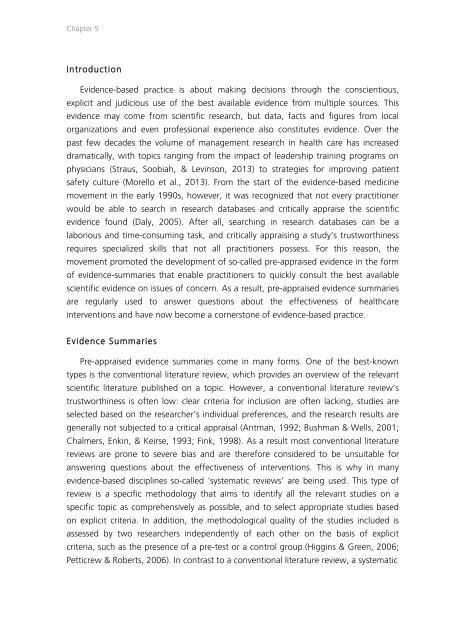In Search of Evidence
jqluvth
jqluvth
Create successful ePaper yourself
Turn your PDF publications into a flip-book with our unique Google optimized e-Paper software.
Chapter 5<br />
<strong>In</strong>troduction<br />
<strong>Evidence</strong>-based practice is about making decisions through the conscientious,<br />
explicit and judicious use <strong>of</strong> the best available evidence from multiple sources. This<br />
evidence may come from scientific research, but data, facts and figures from local<br />
organizations and even pr<strong>of</strong>essional experience also constitutes evidence. Over the<br />
past few decades the volume <strong>of</strong> management research in health care has increased<br />
dramatically, with topics ranging from the impact <strong>of</strong> leadership training programs on<br />
physicians (Straus, Soobiah, & Levinson, 2013) to strategies for improving patient<br />
safety culture (Morello et al., 2013). From the start <strong>of</strong> the evidence-based medicine<br />
movement in the early 1990s, however, it was recognized that not every practitioner<br />
would be able to search in research databases and critically appraise the scientific<br />
evidence found (Daly, 2005). After all, searching in research databases can be a<br />
laborious and time-consuming task, and critically appraising a study’s trustworthiness<br />
requires specialized skills that not all practitioners possess. For this reason, the<br />
movement promoted the development <strong>of</strong> so-called pre-appraised evidence in the form<br />
<strong>of</strong> evidence-summaries that enable practitioners to quickly consult the best available<br />
scientific evidence on issues <strong>of</strong> concern. As a result, pre-appraised evidence summaries<br />
are regularly used to answer questions about the effectiveness <strong>of</strong> healthcare<br />
interventions and have now become a cornerstone <strong>of</strong> evidence-based practice.<br />
<strong>Evidence</strong> Summaries<br />
Pre-appraised evidence summaries come in many forms. One <strong>of</strong> the best-known<br />
types is the conventional literature review, which provides an overview <strong>of</strong> the relevant<br />
scientific literature published on a topic. However, a conventional literature review’s<br />
trustworthiness is <strong>of</strong>ten low: clear criteria for inclusion are <strong>of</strong>ten lacking, studies are<br />
selected based on the researcher’s individual preferences, and the research results are<br />
generally not subjected to a critical appraisal (Antman, 1992; Bushman & Wells, 2001;<br />
Chalmers, Enkin, & Keirse, 1993; Fink, 1998). As a result most conventional literature<br />
reviews are prone to severe bias and are therefore considered to be unsuitable for<br />
answering questions about the effectiveness <strong>of</strong> interventions. This is why in many<br />
evidence-based disciplines so-called ‘systematic reviews’ are being used. This type <strong>of</strong><br />
review is a specific methodology that aims to identify all the relevant studies on a<br />
specific topic as comprehensively as possible, and to select appropriate studies based<br />
on explicit criteria. <strong>In</strong> addition, the methodological quality <strong>of</strong> the studies included is<br />
assessed by two researchers independently <strong>of</strong> each other on the basis <strong>of</strong> explicit<br />
criteria, such as the presence <strong>of</strong> a pre-test or a control group.(Higgins & Green, 2006;<br />
Petticrew & Roberts, 2006). <strong>In</strong> contrast to a conventional literature review, a systematic


